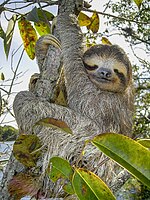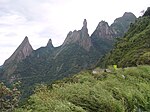This article lists the sites registered with World Heritage to Brazil.
Understand
Listing
| Site | Type | Criterion | Description | Drawing | |||||||||||||||||||||
|---|---|---|---|---|---|---|---|---|---|---|---|---|---|---|---|---|---|---|---|---|---|---|---|---|---|
| 1 Brasilia | Cultural | (i) (iv) | Brasília, the capital created from scratch in the center of the country in 1956-1960, was a major event in the history of town planning. Urban planner Lucio Costa and architect Oscar Niemeyer wanted everything from the general plan of administrative and residential quarters - often compared to the shape of a bird - to the symmetry of the buildings themselves, to reflect the design. harmonious harmony of the city whose official buildings are striking for their innovative appearance. |  | |||||||||||||||||||||
| 2 Historic center of the city ofOlinda | Cultural | (ii) (iv) | The city was founded in the XVIe century by the Portuguese and its history is linked to the sugar cane industry. It was rebuilt after its plunder by the Dutch and most of its urban fabric dates from the 18th century.e century. The preserved balance between the buildings, the gardens, the twenty baroque churches, the convents and the many small chapels ("passos") gives Olinda a very special atmosphere. |  | |||||||||||||||||||||
| 3 Historic center of the city of Diamantina (in the state of Minas Gerais) | Cultural | (ii) (iv) | Diamantina is a colonial town inserted like a jewel in an inhospitable mountain range. It illustrates the adventure of diamond seekers in the 18th century.e century and testifies to the cultural and artistic influence of human beings on their living environment. |  | |||||||||||||||||||||
| 4 Historic center of the city of Goiás (in the state of Goiás) | Cultural | (ii) (iv) | Goiás is a testament to the occupation and colonization of the interior of Brazil in the XVIIIe and XIXe centuries. Its urban design is characteristic of organically developed mining towns, adapted to the realities of the environment. Although modest, the architecture of public and private buildings nonetheless displays great harmony, the result, among other things, of a consistent use of materials and vernacular techniques. |  | |||||||||||||||||||||
| Historic center of Salvador de Bahia | Cultural | (iv) (vi) | | ||||||||||||||||||||||
| São Luís Historic Center (in the state of Maranhão) | Cultural | (iii) (iv) (v) | | ||||||||||||||||||||||
| Modern set of Pampulha (at Contagem in the state of Minas Gerais) | Cultural | (i) (ii) (iv) | | ||||||||||||||||||||||
| Jesuit missions of the Guaranis: San Ignacio Mini, Santa Ana, Nuestra Señora de Loreto and Santa Maria Mayor (Argentina), ruins of Sao Miguel das Missoes (Brazil) | Cultural | (iv) | | ||||||||||||||||||||||
| 5 Serra da Capivara National Park (in the state of Piaui) | Cultural | (iii) | Many of the many rock-carved shelters in Serra da Capivara National Park are adorned with cave paintings some of which date back to over 25,000 years. They provide exceptional testimony to one of the oldest human communities in South America. | .jpg/150px-The_Family_of_Men_(7977911736).jpg) | |||||||||||||||||||||
| São Francisco Square in the city of São Cristóvão (in the state of Sergipe) | Cultural | (ii) (iv) | | ||||||||||||||||||||||
| Rio de Janeiro, Carioca landscapes between the mountain and the sea | Cultural | (v) (vi) | | ||||||||||||||||||||||
| Sanctuary of Bom Jesus in Congonhas (in the state of Minas Gerais) | Cultural | (i) (iv) | | ||||||||||||||||||||||
| Valongo wharf archaeological site (in the center of Rio de Janeiro) | Cultural | (vi) | | ||||||||||||||||||||||
| 6 Historic town of Ouro Preto (in the state of Minas Gerais) | Cultural | (i) (iii) | Founded at the end of the 17th centurye century, the city of Ouro Preto ("Black Gold") was the focal point of the gold rush and the center of the "Golden Age of Brazil" in the 18th century.e century. With the exhaustion of gold mines in the XIXe Century, Ouro Preto's influence waned, but many churches, bridges and fountains remain, testifying to its ancient prosperity and the exceptional talent of the Baroque sculptor Aleijadinho. | .jpg/150px-Ouro_Preto_(7769100536).jpg) | |||||||||||||||||||||
| 7 Pantanal conservation area | Natural | (vii) (ix) (x) | The Pantanal conservation area has four protected areas with a total area of 187,818 ha. Located in west-central Brazil, at the southwestern end of the state of Mato Grosso, it embraces the sources of the Cuiabá and Paraguay rivers. The site represents 1.3% of the Brazilian Pantanal, the main sector of one of the world's largest freshwater wetland ecosystems. Its most spectacular feature is the abundance and diversity of its vegetation and fauna. |  | |||||||||||||||||||||
| Protected areas of Cerrado: National parks 8 Chapada dos Veadeiros and 9 Emas (in the state of Goiás) | Natural | (ix) (x) | The two sites included in this ranking are home to flora, fauna and essential habitats characteristic of the Cerrado - one of the oldest and most diverse tropical ecosystems in the world. For millennia, these sites have served as refuges for several species during periods of climate change, and they will remain essential to maintaining the biodiversity of Cerrado during future climate changes. |  | |||||||||||||||||||||
Central Amazon Conservation Complex
(in the state ofAmazonas) | Natural | (ix) (x) | This site of more than 6 million hectares forms the largest protected area in the Amazon basin and one of the richest regions on the planet in terms of biodiversity. In particular, we find a significant example of varzea ecosystems, igapó forests, lakes and rivers that form an aquatic mosaic in which the greatest diversity of electric fish in the world evolves. The site is home to critically important endangered species, including the giant arapaima, Amazon manatee, black caiman and two species of freshwater dolphins. |  | |||||||||||||||||||||
Discovery Coast - Atlantic Forest Reserves
(in the states of Bahia and D'Espírito Santo) | Natural | (ix) (x) | The Brazilian Discovery Coast, located in the states of Bahía and Espirito Santo, consists of eight protected areas that contain 112,000 ha of Atlantic forest and associated shrubs (restingas). The Atlantic Forest is the richest rainforest in the world in terms of biodiversity. The Discovery Coast is home to a wide range of species with a high level of endemism. It reveals a pattern of evolution of great interest for science and conservation. |  | |||||||||||||||||||||
| 14 Atlantic Forest - Southeast Reserves | Natural | (vii) (ix) (x) | Located in the states of Paraná and São Paulo, this forest is home to some of the best - and most extensive - examples of the Brazilian Atlantic Forest. The twenty-five protected areas that make up this site cover approximately 470,000 ha and illustrate the biological richness and evolution of the last vestiges of the Atlantic forest. From mountains covered with dense forests to wetlands, to coastal islands with their mountains and isolated dunes, this site presents a rich natural environment of great beauty. |  | |||||||||||||||||||||
| Brazilian Atlantic Islands: Fernando de Noronha and Atol das Rocas Reserves (in the states of Pernambuco and Rio Grande do Norte) | Natural | (vii) (ix) (x) | | ||||||||||||||||||||||
| Iguaçu National Park (in the state of Paraná) | Natural | (vii) (x) | | ||||||||||||||||||||||
| Paraty and Ilha Grande - culture and biodiversity | Mixed | (v) (x) | This natural-cultural landscape encompasses the historic center of Paraty, one of the best-preserved coastal towns in Brazil, four protected natural areas of the Brazilian Atlantic Forest, one of the world's five biodiversity hotspots, as well as part of the Serra da Bocaina mountain range and the Atlantic coastal region. Serra do Mar and Ilha Grande Bay are home to an impressive diversity of animal species, some of which are endangered, such as the jaguar (Panthera onca), the white-lipped peccary (Tayassu pecari) and several species of primates, including the arachnoid atele (Brachyteles arachnoides), emblematic of the property. At the end of the XVIIe century, Paraty was the end point of the Caminho do Ouro (Gold Route), along which gold was shipped to Europe. Its port also served as an entry point for African tools and slaves, sent to work in the mines. A defense system was built to protect the wealth of the port and the city. The historic center of Paraty has retained its 18th century plane century and much of its colonial architecture dating from XVIIIe and the start of XIXe century. |  | |||||||||||||||||||||
Criteria legend
| |||||||||||||||||||||||||
